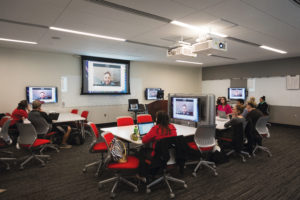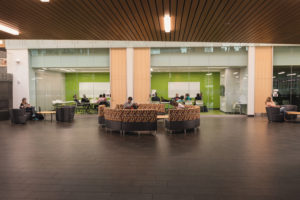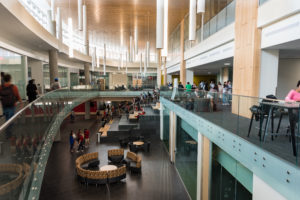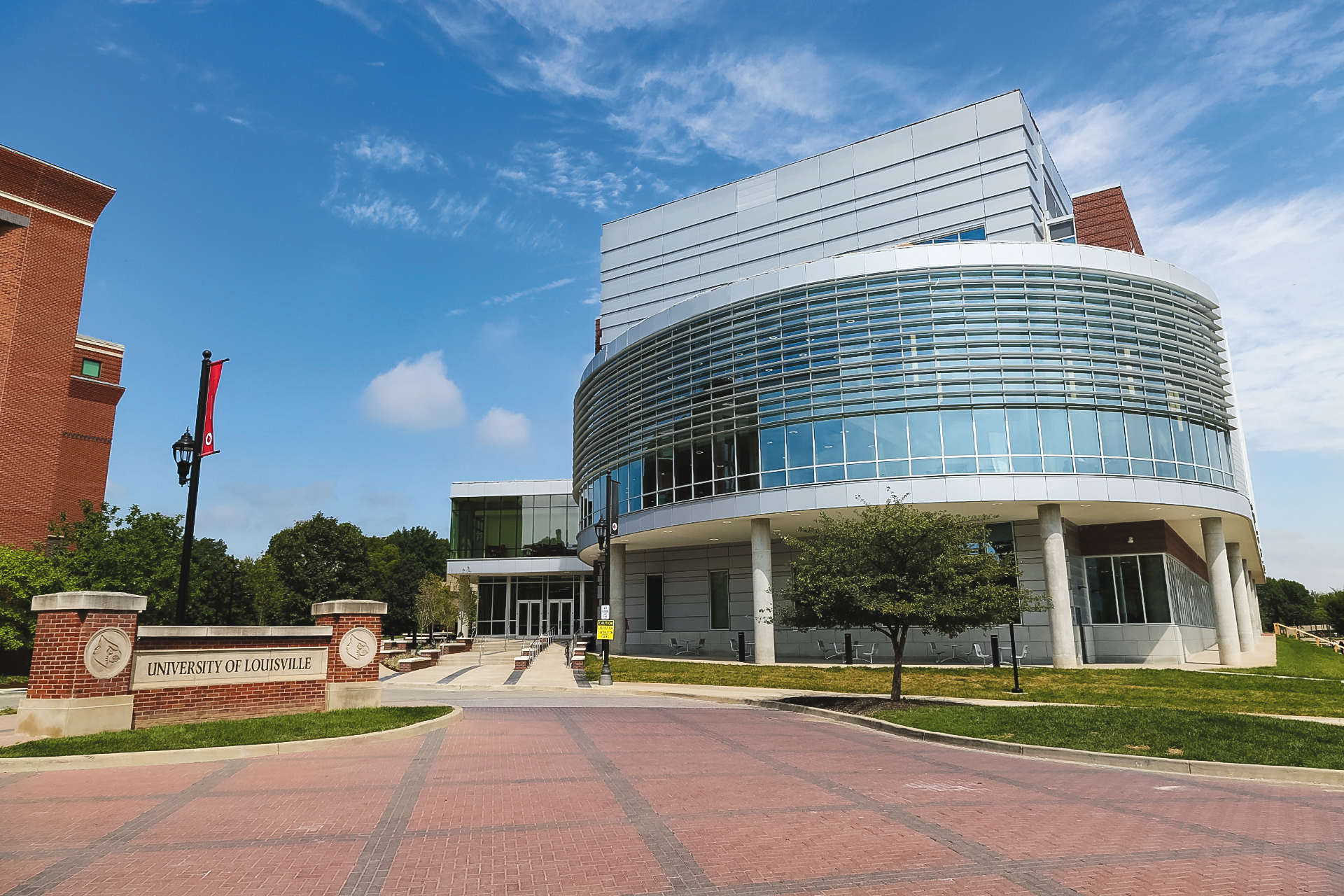On any weekday, swarms of students can be found inside the Belknap Campus’s newest crown jewel for learning — the Belknap Academic Building.
The 165,000-square-foot, $80 million facility—a project more than two years in the making—helps rectify UofL’s shortage of classroom space and ushers in a new era of active learning methods proven to foster student engagement. The building contains more than 50 technology-rich classrooms, labs, seminar rooms, group study areas and common areas designed to encourage student interaction.
“The University of Louisville has struggled with providing high-quality classroom space that matches up to the high-quality instructors and the high-quality instruction that we provide,” said President Neeli Bendapudi. “Our hope is this building sends a powerful signal to the world that UofL will continue to thrive and excel as an academic institution.”
The building is located where the legendary Crawford Gym once stood. In a nod to the past, the first-floor benches are made of wood recycled from the Crawford Gym floor. Since its opening, these benches have become busy social spaces along with the common areas and informal meeting spaces.
What you won’t find in the building? A traditional, large lecture hall with auditorium seating.
An Active Attitude
The Belknap Academic Building was constructed specifically to encourage active learning, an interactive, student-centered approach to teaching that stretches back throughout the past 30 years.

“Innovation in higher education is essential and traditional. Research on learning and in brain science has demonstrated that interactive, student-centered teaching methods position students for greater success,” said Gale Rhodes, executive director of the Delphi Center for Teaching and Learning.
Classrooms include moveable furniture, whiteboards for student use, and technology that allows multiple users — faculty and students alike — to share content from their smartphones and laptops to the in-room displays. The building also has many informal meeting spaces for group work and projects
outside of class time.
“The reason we need a building with new types of learning spaces is that they represent our improved understanding of the role technology, space and pedagogy can play in student learning and student success,” said Jeff Hieb, assistant professor of engineering fundamentals in the Speed School. “The spaces improve student interaction, allow faculty to have high-quality interactions with small groups of students, and the technology is designed to promote collaboration, which is a skill students need to develop.”
There are plenty of universities and colleges that have active learning classrooms, but very few have entire classroom buildings dedicated to active learning. With the BAB, UofL is now one of a small group of universities in the country to have a large classroom building dedicated to active learning classrooms.
“[The building] represents the new future of teaching, allowing our university to meet educational needs in ways we never have before,” Rhodes said.
The Heart of Student Success
The Belknap Academic Building also houses the university’s Student Success Center, which focuses on first-year programming efforts to support retention, offers exploratory advising and has staff dedicated to helping students overcome obstacles and complete the path to graduation. The Resources for Academic Achievement (REACH) program also is located in the new building.

“These services are essential to student success and they belong in the
same building,” Provost Beth Boehm said. “We are trying to provide constant, intensive support for our students. Our goal is for them not just to succeed but
to excel.”
Having all the services in a one-stop shop, coupled with other student success-driven programs, means a greater ability to provide immediate assistance to students and foster a high-touch, high-tech approach to academic support, according to Geoff Bailey, REACH executive director.
“Students will be able to travel from many of their classes directly to our centers and staff, which helps reduce physical and other perceived barriers for access,” Bailey said. “Further, given our close proximity to our partners, we’ll also see enhanced collaborations and referrals that will directly benefit students.”
Something for Everyone
Much ado has been made about the Belknap Academic Building since its plans were unveiled. But, what do the students think about the new space?
So far, they love it.
Nicole Harris, a sophomore mechanical engineering major, hangs out in the BAB during a gap between classes on Tuesdays.

“I live off-campus, so it’s nice to have this place to go. It’s a nice, big, comfortable space. It seems like a lot of people take advantage of the different types of spaces that are here,” Harris said.
Students have also noticed how the building helps enhance their classroom experiences. Jacqueline Lizotte, a junior anthropology major from Harrisonburg, Virginia, has two classes there this semester, and said the classrooms are “very conducive to group
participation.”
It’s not just the upperclassmen who are enjoying the space, either. A trio of freshmen — Royster Strickland, Taylor Brock and Emily Beltchev — said they use the space for studying.
“We usually come here to study because it’s quieter than the SAC (Student Activities Center). The SAC is more for eating and socializing. This is more of a working space,” Brock said.
“I came from a huge, cramped high school with over 2,000 students, so this building is very different. It’s so big, inviting and contemporary,” Beltchev said.




























